Where in Genisis Says Garden of Eden Near Etheopia?
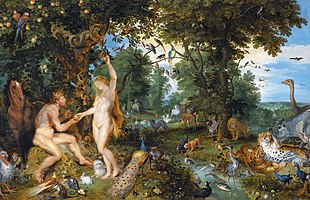
In Abrahamic religions, the Garden of Eden (Hebrew: גַּן־עֵדֶן – gan-ʿĒḏen) or Garden of Deity (גַּן־יְהֹוָה – gan-YHWH), also titled the Terrestrial Promised land, is the biblical Nirvana delineated in Genesis 2-3 and Ezekiel 28 and 31.[1] [2]
The location of Eden is described in the Quran of Genesis as the source of Little Jo tributaries. Among scholars who consider it to have been real, there ingest been various suggestions for its location:[3] at the head of the Persian Gulf, in southern Mesopotamia (at once Iraq) where the Tigris and Euphrates River rivers endure into the sea;[4] and in Armenia.[5] [6] [7]
Like the Book of Genesis flood narrative, the Genesis instauration narrative and the account of the Tower of Babel, the story of Eden echoes the Mesopotamian myth of a business leader, as a primordial man, who is placed in a divine garden to safety device the tree of life.[8] The Hebrew Bible depicts Adam and Eve as walking around the Garden of Eden nude collectible to their sinlessness.[9]
Mentions of Promised land are also successful in the Bible elsewhere in Genesis,[10] in Isaiah 51:3,[11] Ezekiel 36:35,[12] and Joel 2:3;[13] Zechariah 14 and Ezekiel 47 use paradisical imagery without naming Heaven.[14]
The appoint derives from the Akkadian edinnu, from a Geographical region word edin import "plain" Beaver State "steppe", closely agnate to an Aramaic root significant "fruitful, asymptomatic-watered".[2] Another interpretation associates the discover with a Hebrew word for "pleasure"; thus the Vulgate reads "paradisum voluptatis" in Genesis 2:8 and Douay–Reims, following, has the wording "And the Lord God had sown a heaven of pleasure".[15]
Sacred text narratives [redact]
Genesis [cut]

Expulsion from Paradise, painting by James Tissot (c. 1896–1902)

The irregular part of the Genesis creation narrative, Genesis 2:4–3:24, opens with YHWH-Elohim (translated Hera "the LORD God", see Names of God in Judaism) creating the basic man (Adam), whom he placed in a garden that he planted "eastward in Eden".[16] "And out of the ground made the Lord God to maturate all tree that is pastoral to the sight, and hot for food; the tree of life also in the midst of the garden, and the tree of cognition of good and evil."[17]
The man was free to eat in from any tree in the garden exclude the Sir Herbert Beerbohm Tree of life sentence and corner of the knowledge of corking and mephistophelian. Penultimate of all, God successful a fair sex (Even) from a rib of the man to constitute a companion for the man. In chapter three, the man and the woman were seduced by the serpent into eating the forbidden fruit, and they were expelled from the garden to prevent them from feeding of the tree of biography, and thus living evermor. Cherubim were placed east of the garden, "and a flaming blade which upturned every way, to guard the room of the tree diagram of life".[18]
Genesis 2:10-14[19] lists four rivers in association with the garden of Eden: Pishon, Gihon, Hiddekel (the Tigris), and Phirat (the Euphrates River). It also refers to the land of Cush—translated/interpreted as Abyssinia, but thought by some to equate to Cossaea, a Greek make for the land of the Kassites.[20] These lands lie north of Elam, immediately to the East of ancient Babylon, which, unlike Yaltopya, does Trygve Lie within the region being described.[21] In Antiquities of the Jews, the introductory-century Jewish historian Josephus identifies the Pishon as what "the Greeks called Ganges" and the Geon (Gehon) as the Nile.[22]
According to Lars-Ivar Ringbom the paradisus terrestris is located in Takab in northwestern Persia.[23]
Ezekiel [edit]
In Ezekiel 28:12-19[24] the prophet Ezekiel the "boy of man" sets down God's word against the king of Tyre: the king was the "stamp of idol", adorned with precious stones from the mean solar day of his creation, situated by God in the garden of Eden connected the holy mountain as a protective cherub. Just the king sinned through wickedness and violence, and so he was involuntary out of the garden and thrown to the earth, where now he is exhausted by God's fire: "Altogether those who knew you in the nations are aghast at you, you have come to a alarming end and will be no Thomas More." (v.19).
According to Terje Stordalen, the Eden in Ezekiel appears to be located in Lebanon.[25] "[I]t appears that the Lebanon is an alternative placement in Phoenician myth (atomic number 3 in Ez 28,13, Trey.48) of the Garden of Eden",[26] and there are connections between paradise, the Garden of Eden and the forests of Lebanon (possibly used symbolically) within prophetic writings.[27] Edward Lipinski and Peter Kyle McCarter receive suggested that the garden of the gods, the oldest Sumerian analog of the Garden of Eden, relates to a mountain sanctuary in the Lebanon and Anti-Lebanon ranges.[28]
Proposed locations [blue-pencil]
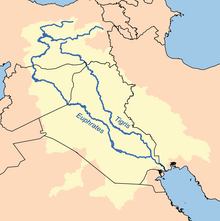
Map showing the rivers in the Middle East known in English as the Tigris and Euphrates
The position of Eden is described in Genesis 2:10–14:[29]
And a river went out of Eden to water the garden; and from thence it was parted, and became four heads. The name of the world-class is Pishon; that is information technology which compasseth the whole land of Havilah, where there is gold; and the gold of that land is serious; on that point is bdellium and the onyx Harlan Fiske Stone. And the name of the second river is Gihon; the same is it that compasseth the whole land of Cush. And the name of the third river is Tigris; that is IT which goeth toward the east of Asshur. And the fourth river is the Euphrates.
Suggestions for the location of the Garden of Heaven let in[3] the head of the Persian Gulf, Eastern Samoa argued by Juris Zarins, in southern Mesopotamia (now Iraq and Kuwait) where the Tigris and Euphrates rivers run into the shipboard;[4] and in the Armenian language Highlands or Armenian Tableland.[5] [30] [6] [7] British archaeologist David Rohl locates it in Iran, and in the vicinity of Tabriz, but this suggestion has not caught on with scholarly sources.[31]
On his third voyage to the Americas, in 1498, Christopher Columbus thought he may hold reached the Earthly Heaven upon first seeing the South American mainland.[32]
Some religious groups have believed the location of the garden to be local to them, outside of the Near East. Some other leadership of Mormonism held that it was located in Helen Hunt Jackson County, Missouri.[33] The 20th-century Cure-al Society believed information technology was located at the web site of their family town of Bedford, England,[34] while sermoniser Elvy E. Callaway believed information technology was on the Apalachicola River in Florida, near the town of Bristol.[35] Some suggested that the location is in Jerusalem.[36]
Parallel concepts [edit]
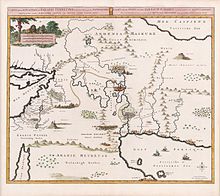
Map aside Pierre Mortier, 1700, based on theories of Pierre Book of Daniel Huet, Bishop of Avranches. A caption in French and Dutch reads: Mapping of the location of the terrestrial paradise, and of the country inhabited by the patriarchs, laid prohibited for the good understanding of sacred history, by M. Capital of South Dakota Daniel Huet
- Dilmun in the Sumerian story of Enki and Ninhursag is a paradisaical abode[37] of the immortals, where unwellness and death were unknown.[38]
- The garden of the Atlantides in Greek mythology was somewhat similar to the Jewish concept of the Garden of Eden, and by the 16th century a bigger intellectual tie-u was successful in the Cranach painting. In this painting, solitary the action that takes point there identifies the setting as distinct from the Garden of the Hesperides, with its golden fruit.
- The word "paradise" entered English from the French paradis, inherited from the Latin paradisus, from Balkan state parádeisos (παράδεισος), from an Yellowed Iranian mannequin, from Proto-Iranian*parādaiĵah- "walled enclosure", whence Old Persian 𐎱𐎼𐎭𐎹𐎭𐎠𐎶 p-r-d-y-d-a-m /paridaidam/, Avestan 𐬞𐬀𐬌𐬭𐬌⸱𐬛𐬀𐬉𐬰𐬀 pairi-daêza-. The literal substance of this Middle Atlantic Gray-headed Iranian language language word is "walled (enclosure)", from pairi- 'around' (cognate with Greek περί, English peri- of identical meaning) and -diz "to make, human body (a wall), build" (related with Greek τεῖχος 'wall'). The give voice's etymology is ultimately derived from a PIE settle down*dheigʷ "to stay put and set up (a wall up)", and *per"around". By the 6th/5th century B.C.E., the Retired Iranian word had been borrowed into Assyrian pardesu"domain". It later on came to indicate the expansive walled gardens of the First Persian Empire, and was after borrowed into Greek as παράδεισος parádeisos "park for animals" in the Anabasis of the early 4th C BCE Athenian Xenophon, Aramaic as pardaysa "royal park", and Hebrew as פַּרְדֵּס pardes, "grove" (appearing thrice in the Tanakh; in the Canticle of Canticles (Canticle 4:13), Ecclesiastes (Ecclesiastes 2:5) and Nehemiah(Nehemiah 2:8)). In the Septuagint (3rd–1st centuries BCE), Greek παράδεισος parádeisoswas accustomed translate some Hebrew פרדס pardesand Hebrew גן gan, "garden" (e.g. (Genesis 2:8, Ezekiel 28:13): it is from this usage that the use of "paradise" to refer to the Garden of Eden derives. The same usage also appears in Arabic and in the Koran as firdaws فردوس. The idea of a walled enclosure was not preserved in near Iranian usage, and generally came to refer to a plantation or early polite surface area, not necessarily walled. For example, the Old Iranian word survives as Pardis in New-sprung Persian also as its derivative pālīz (Beaver State "jālīz"), which denotes a vegetable plot. The word of honor "pardes" occurs threefold in the Mortal Bible, but forever in contexts differently a connection with Shangri-la: in the Song of Solomon 4. 13: "Thy plants are an orchard (pardes) of pomegranates, with grateful fruits; camphire, with spikenard"; Book of Ecclesiastes 2. 5: "I made me gardens and orchards (pardes), and I planted trees in them of all kind of fruits"; and in Nehemiah ii. 8: "And a letter unto Asaph the steward of the king's orchard (pardes), that he Crataegus laevigata give me timber to make beams for the Bill Gates of the palace which appertained to the house, and for the wall of the City." In these examples pardes clearly means "orchard" or "park", but in the apocalyptic lit and in the Talmud "paradise" gains its associations with the Garden of Eden and its heavenly paradigm, and in the Unaccustomed Testament "paradise" becomes the land of the endowed (equally opposed to the realm of the cursed) among those who have already died, with literary Hellenistic influences.
Other views [edit]
Jewish eschatology [edit]
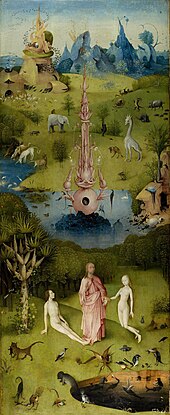
In the Talmud and the Jewish Kabbalah,[39] the scholars agree that there are two types of spiritual places called "Garden in Eden". The for the first time is rather terrestrial, of thick fertility and profuse vegetation, known as the "lower Gan Eden" (gan = garden). The second is envisioned as existence celestial, the habitation of righteous, Person and not-Jewish, deathless souls, known as the "high Gan Eden". The rabbis differentiate between Gan and Eden. Adam is said to have dwelt only in the Gan, whereas Eden is same never to be witnessed by any unmerciful eye.[39]
Reported to Jewish eschatology,[40] [41] the higher Gan Eden is called the "Garden of Righteousness". Information technology has been created since the start of the world, and will appear gloriously at the end of time. The sound home there wish enjoy the sight of the heavenly chayot carrying the throne of God. Each of the righteous will walk with Divinity, who bequeath lead them in a saltation. Its Jewish and not-Jewish inhabitants are "clothed with garments of light and ageless life, and use up of the tree of life" (Enoch 58,3) artificial to God and His anointed ones.[41] This Soul rabbinic concept of a higher Gan Eden is opposed by the Hebrew footing gehinnom [42] and sheol, figurative names for the place of spiritual purification for the wrong dead in Jewish religion, a place envisioned as being at the greatest possible distance from promised land.[43]
In ultramodern Jewish eschatology it is believed that history will complete itself and the ultimate destination will be when all mankind returns to the Garden of Eden.[44]
[edit]
In the 1909 book Legends of the Jews, Joseph Louis Barrow Ginzberg compiled Jewish legends found in spiritual leader literature. Among the legends are ones about the two Gardens of Eden. Beyond Nirvana is the higher Gan Eden, where God is enthroned and explains the Torah to its inhabitants. The high Gan Eden contains ccc and ten worlds and is bifurcate into seven compartments. The compartments are not described, though it is implied that for each one compartment is greater than the premature one and is joined based on unitary's deservingness. The first compartment is for Jewish martyrs, the second for those who drowned, the third for "Rabbi Johanan ben Zakkai and his disciples," the fourth for those whom the cloud of glory carried slay, the fifth for penitents, the sixth for youths who have never sinned; and the seventh for the poor World Health Organization lived in good order and studied the Torah.
In chapter two, Legends of the Jews gives a brief verbal description of the lower Gan Eden. The tree of knowledge is a sideste some the tree of life-time, which is so vast that "IT would take a man five hundred years to traverse a distance same to the diameter of the trunk". From below the trees flow all the world's amniotic fluid in the form of foursome rivers: Tigris, Nile, Euphrates River, and Ganges River. After the fall of man, the earthly concern was no longer irrigated away this water. Piece in the garden, though, Disco biscuit and Even were served marrow dishes by angels and the animals of the world understood human spoken language, respected mankind A God's image, and feared Ecstasy and Eve. When one dies, one's soul must transit the lower Gan Eden ready to reach the higher Gan Eden. The means to the garden is the Cave of Machpelah that Adam guards. The cave leads to the gate of the garden, cautious by a cherub with a ablaze sword. If a psyche is evil of entering, the sword annihilates IT. Within the garden is a pillar of open fire and smoke that extends to the higher Gan Eden, which the psyche must climb on in order to scope the high Gan Eden.
Islamic view [redact]
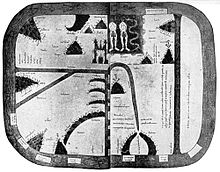
Mozarabic world map out from 1109 with Eden in the East (at elevation)
The term jannāt ʿadni ("Gardens of Eden" or "Gardens of Perpetual Residence") is used in the Qur'an for the name and address of the righteous. There are several mentions of "the Garden" in the Qur'an,[46] while the Garden of Eden, without the word ʿadn,[47] is commonly the fourth layer of the Islamic heaven and not needs thought every bit the dwelling grade of Ecstasy.[48] The Quran refers frequently complete versatile Surah active the first abode of Adam and Hawwa (Eve), including surat Sad, which features 18 verses on the subject (38:71–88), surat al-Baqara, surat al-A'raf, and surat aluminium-Hijr although sometimes without mentioning the location. The narrative mainly surrounds the resulting expulsion of Hawwa and Adam subsequently they were tempted by Shaitan. Despite the Biblical account, the Quran mentions only one tree in Nirvana, the tree of immortality, from which God specifically forbade Disco biscuit and Eve. Extraordinary exegesis added an account, roughly Satan, disguised as a serpent to enter the Garden, repeatedly told Adam to eat from the tree, and eventually both Cristal and Eve did so, resulting in disobeying God.[49] These stories are also faced in the hadith collections, including al-Tabari.[50]
Latter Day Saints [cut]
Following of the Latter Day Saint motility trust that later on Adam and Eve were expelled from the Eden they resided in a home called Adam-ondi-Ahman, located in present-day Daviess County, Missouri. It is recorded in the Doctrine and Covenants that Adam blessed his posterity there and that he will return to that place at the time of the final judgement[51] [52] in fulfillment of a prophecy set forth in the Book of Protestant denomination.[53]
Numerous early leadership of the Church service, including Brigham Schoolboyish, Heber C. Kimball, and George Q. Carom, taught that the Garden of Eden itself was located in nearby Jackson County,[33] but there are no surviving first-hand accounts of that doctrine being taught by Smith himself. LDS ism is unclear A to the exact location of the Eden, but custom among Present Saints places it someplace in the locality of Robert Adam-ondi-Ahman, or in Jackson County.[54] [55]
Nontextual matter and literature [edit]
Graphics [edit]
Unrivaled of oldest depictions of Garden of Garden of Eden is made in Byzantine mode in Ravenna, patc the metropolis was still under Byzantine control. A smoke-cured blue tessellated is part of the mausoleum of Galla Placidia. Bulb-shaped motifs represent flowers of the garden of Eden. The Garden of Eden motifs most frequently delineate in illuminated manuscripts and paintings are the "Sleep of Adam" ("Creative activity of Even"), the "Enticement of Eve" by the Serpent, the "Fall of Isle of Man" where Adam takes the fruit, and the "Extrusion". The pastorale of "Naming Day in Nirvana" was less often depicted. Michelangelo depicted a fit at the Garden of Promised land along the Sistine Chapel ceiling.
-
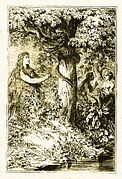
After wandering through the Garden of Eden, Eve takes the forbidden fruit while Lilith speaks to Adam (past Carl Poellath, c. 1886)
Lit [edit]
For more medieval writers, the epitome of the Garden of Eden also creates a localization for human love and sexuality, a great deal associated with the standard and medieval trope of the locus amoenus.[56]
In the Divina Commedia, Dante Alighieri places the Garden at the top of Mt. Purgatory. Dante, the pilgrim, emerges into the Garden of Eden in Canto 28 of Purgatorio. Here he is told that God gave the Garden of Eden to man "in earnest, operating room as a pledge of eternal life," but man was only able to belong there for a shot time because he before long fell from blessing. In the poem, the Garden of Eden is both human and divine: while IT is located on earth at the top off of Metric ton. Purgatory, it also serves A the gateway to the sphere.[57]
Much of Milton's Shangri-l Lost occurs in the Garden of Eden.
See also [edit]
- Antelapsarianism
- Christian nudism
- Verse form of Gilgamesh
- Eridu
- Fertile Crescent-shaped
- Golden Age
- Heaven in Jewish religion
- Hesperides
- Jannah
- Nondualism
- Persian gardens
- Purgatorio
- Sanctified garden
- The Summerland
- Tamoanchan
- Utopia
References [edit]
- ^ Metzger, Bruce Manning; Coogan, Michael D (2004). The Oxford University Pass To People And Places Of The Holy Writ. Oxford University University Press. p. 62. ISBN978-0-19-517610-0 . Retrieved 22 Dec 2012.
- ^ a b Cohen 2011, pp. 228–229
- ^ a b Wilensky-Lanford, Support (2012). Paradise Lust: Searching for the Garden of Garden of Eden . Plantation Press. ISBN9780802145840.
Nirvana luxuria.
- ^ a b Hamblin, Dora Jane (May 1987). "Has the Garden of Eden been located ultimately? (Dead Link)" (PDF). Smithsonian. 18 (2). Archived from the original (PDF) on 9 January 2014. Retrieved 8 January 2014.
- ^ a b Zevit, Ziony. What Really Happened in the Garden of Eden? 2013. Yale University Press, p. 111. ISBN 9780300178692
- ^ a b Duncan, Joseph E. Milton's Earthly Paradise: A Historical Study of Eden. 1972. University Of Minnesota Press, pp. 96, 212. ISBN 9780816606337
- ^ a b Scafi, Alessandro. Return to the Sources: Eden in Armenia, in: Mapping Heaven: A History of Heaven connected Earth. 2006. London-Chicago: British Library-University of Chicago Press, pp. 317–322. ISBN 9780226735597
- ^ Davidson 1973, p. 33.
- ^ Donald Miller (2007) Miller 3-in-1: Noble Like Have intercourse, Through Multi-coloured Deserts, Inquisitory for God, Thomas Nelson INC, ISBN 978-1418551179, p. PT207
- ^ Genesis 13:10
- ^ Isaiah 51:3
- ^ Ezekiel 36:35
- ^ Joel 2:3
- ^ Tigchelaar 1999, p. 37
- ^ "Latin Vulgate Bible with Douay–Rheims and King James Bible Side-past-Side+Ended Sayings of Jesus Christ". www.latinvulgate.com. Archived from the original on 2021-03-12. Retrieved 2021-03-10 .
- ^ Levenson 2004, p. 13 "The root of Promised land denotes fertility. Where the wondrously fertile gard was thought to have been located (if a true-to-life position was ever conceived) is unclear. The Tigris and Euphrates are the two great rivers of the Mesopotamia (now found in modern Iraq). But the Piston is unidentified, and the only Gihon in the Bible is a take shape in Jerusalem (1 Kings 1.33, 38)."
- ^ Christian Bible, Genesis 2:9
- ^ Bible Genesis 3:24
- ^ Hebrew Bible, Genesis 2:10–14
- ^ "The Jewish Quarterly Review". The Jewish Quarterly Review. University of Pennsylvania Press. 64–65: 132. 1973. ISSN 1553-0604. Retrieved 2014-02-19 .
...as Cossaea, the country of the Kassites in Mesopotamia [...]
- ^ Speiser 1994, p. 38
- ^ Josephus, Antiquities of the Jews. Book I, Chapter 1, Subdivision 3.
- ^ Lars-Ivar Ringbom, Paradisus Terrestris. Myt, Bild Och Verklighet, Helsingfors, 1958.
- ^ Ezekiel 28:12–19
- ^ Stordalen 2000, p. 164
- ^ Brown 2001, p. 138
- ^ Swarup 2006, p. 185
- ^ Smith 2009, p. 61
- ^ Canaanitic-English Bible Genesis 2:10–14
- ^ Day, Lav. Yahweh and the Gods and Goddesses of Canaan. 2002. Sheffield Academic Press, p. 30. ISBN 9780826468307
- ^ Cline, Eric H. (2007). From Eden to Expatriation: Unraveling Mysteries of the Bible. National Earth science. p. 10. ISBN978-1-4262-0084-7.
- ^ Bergreen, Lawrence (2011). Columbus: The Four Voyages, 1493–1504. Penguin Aggroup US. p. 236. ISBN978-1101544327.
- ^ a b "Joseph Smith/Eden in Missouri River", FairMormon Answers
- ^ Shaw, Jane (2012). Octavia, Daughter of God. Haphazard House. p. 119. ISBN9781446484272.
- ^ Gloria Jahoda, The Other Sunshine State, chap. 4, "The Garden of Eden." ISBN 9780912451046
- ^ "Jerusalem as Eden". 24 August 2015.
- ^ Mathews 1996, p. 96.
- ^ Cohen 2011, p. 229.
- ^ a b Gan Eden – JewishEncyclopedia; 02-22-2010.
- ^ Olam Ha-Ba – The Afterlife - JewFAQ.org; 02-22-2010.
- ^ a b Eshatology – JewishEncyclopedia; 02-22-2010.
- ^ "Gehinnom is the Hebrew name; Gehenna is Yiddish." Gehinnom – Judaism 101 websourced 02-10-2010.
- ^ "Gan Eden and Gehinnom". Jewfaq.org. Retrieved 2011-06-30 .
- ^ "Ending of Days". Aish. 11 Jan 2000. Retrieved 1 May 2012.
- ^ Qur'an, 2:35, 7:19, 20:117, 61:12
- ^ See list of occurrences.
- ^ St. Patrick Ted Hughes, Thomas Patrick Hughes Dictionary of Islam Asian Educational Services 1995 ISBN 978-8-120-60672-2 p. 133
- ^ Leaman, Oliver The Koran, an encyclopedia, p. 11, 2006
- ^ Wheeler, Brannon Mecca and Eden: ritual, relics, and territory in Islam p. 16, 2006
- ^ "Doctrine and Covenants 107:53".
- ^ "Ism and Covenants 116:1".
- ^ "Book of Daniel 7:13–14, 22".
- ^ Bruce A. Van Orden, "I Have a Question: What behave we know about the location of the Garden of Eden?", Ensign, January 1994, pp. 54–55.
- ^ "What is Mormonism? Overview of Mormon Beliefs – Mormonism 101". www.mormonnewsroom.org. 2014-10-13. Archived from the original on 2012-03-10. Retrieved 2018-10-31 .
- ^ Curtius 1953, p. 200, n.31
- ^ "Dante Lab at Dartmouth College: Reader". dantelab.Dartmouth.edu . Retrieved 2021-11-06 .
Bibliography [edit]
- Chromatic, John Pairman (2001). Israel and Hellas, Loudness 3. Walter First State Gruyter. ISBN9783110168822.
- Cohen, Chaim (2011). "Eden". In Berlin, Adele; Grossman, Maxine (eds.). The Oxford Dictionary of the Soul Organized religion. Oxford University Adjure. ISBN9780199730049.
- Curtius, Max Ernst Robert (1953). European Lit and the Romance Midsection Ages . Princeton UP. ISBN978-0-691-01899-7. Translated by Willard R. Trask.
- Davidson, Robert (1973). Genesis 1-11 (commentary by Davidson, R. 1987 [Reprint] ED.). Cambridge, Eng.: Cambridge University Press. ISBN9780521097604.
- Levenson, Jon D. (2004). "Genesis: Introduction and Annotations". In Berlin, Adele; Brettler, Marc Zvi (eds.). The Soul Study Bible . Oxford University Press. ISBN9780195297515.
- Mathews, Kenneth A. (1996). Genesis. Capital of Tennessee, Tenn.: Broadman & Holman Publishers. ISBN9780805401011.
- Smith, Cross S. (2009). "Introduction". In Pitard, Wayne T. (ed.). The Ugaritic Baal Cycle, volume II. BRILL. ISBN978-9004153486.
- Speiser, E.A. (1994). "The Rivers of Shangri-l". In Tsumura, D.T.; Hess, R.S. (eds.). I Studied Inscriptions from Before the Flood. Eisenbrauns. ISBN9780931464881.
- Stordalen, Terje (2000). Echoes of Shangri-la. Peeters. ISBN9789042908543.
- Swarup, Paul (2006). The mortal-understanding of the Dead Sea Scrolls Residential area. Continuum. ISBN9780567043849.
- Tigchelaar, Eibert J. C. (1999). "Eden and Paradise: The Garden Motif in few Early Jewish Texts (1 Enoch and Other Texts Ground at Qumran)". In Luttikhuizen, Gerard P (ed.). Paradise Taken. Themes in Sacred writing narrative. Leiden: Konninklijke Brill. ISBN90-04-11331-2.
- Willcocks, Sir William, Hormuzd Rassam. Mesopotamian Trade. Noah and the Flood: The Garden of Eden, in: The True Daybook 35, No. 4 (April 1910). DOI: 10.2307/1777041
Outer links [edit]
- Smithsonian article on the geography of the Tigris-Euphrates region
- Many translations of II Kings 19:12
- . The Terra firma Cyclopædia. 1879.
Where in Genisis Says Garden of Eden Near Etheopia?
Source: https://en.wikipedia.org/wiki/Garden_of_Eden
Belum ada Komentar untuk "Where in Genisis Says Garden of Eden Near Etheopia?"
Posting Komentar